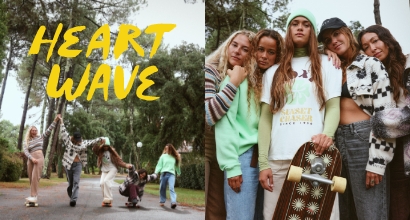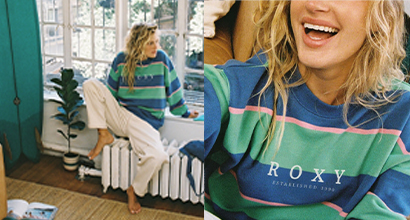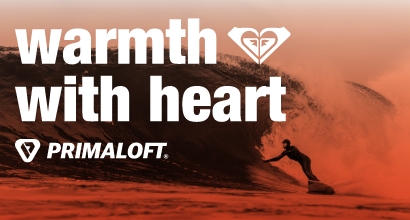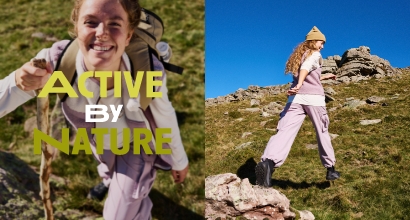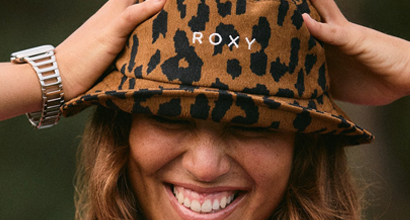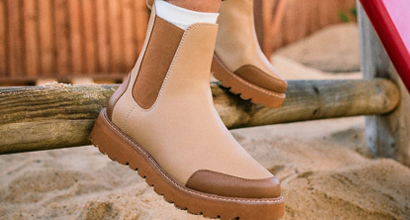-
Login / Register
ROXY GIRL CLUB
Free shipping & returns for members
How To Pick the Perfect Womens Sports Bra Whatever the Workout
The right sports bra will enhance your workout experience. Wearing different bras for different activities, varying compression, coverage, and strap type is essential for comfort. With such a range of styles, materials, fits it can be difficult to find a sports bra you can feel confident in.
We’ve got your back. We will walk through everything you need to know to find perfectly fitting womens sports bras.
Why Wearing a Sports Bra Is Important
Working out causes bouncing, which puts strain on the Cooper’s ligaments — the connective tissue which connects breast tissue to pectoral muscles. A good sports bra will reduce bouncing, decreasing pain and soreness, removing one of the main barriers to exercise many women face. The right type, shape and thickness of strap will allow you to move more freely and provide more support than everyday bras. And, the proper material will wick away sweat, helping your body to cool down, leaving you feeling fresher for longer.
Fit Guide: How To Find a Sports Bra That Fits
Two measurements determine what bra size to wear:
- Band Size — also known as underband or back size.
- Cup Size— the difference between your bust measurement and band size
Tip: Make sure to take your measurements while wearing a non-padded bra or nothing at all.
How To Measure Band Size
- Using a soft tape measure, wrap it around your ribcage directly under your bust, and below the underwiring if wearing a wired bra.
- Measure in inches, rounding down to the nearest full even inch.
- Add 4. So if you measure 31.5 you’ll round down to 30 and then add 4, you get a band size of 34.
How To Measure Cup Size
Keeping the tape measure straight across your back, measure the fullest part of your bust. Round up to the nearest full inch to get your bust measurement. This minus your ribcage measurement is your cup size. So if your bust is 35 inches, take away 30 inches underbust you get 5 which is a B cup.
Sports Bra Size Chart
| Bust Size Minus Size of Ribcage | Cup Size |
|---|---|
| 3 | AA |
| 4 | A |
| 5 | B |
| 6 | C |
| 7 | D |
| 8 | DD or E |
| 9 | DDD or F |
| 10 | DDDD or G |
Bra Sister Sizes
The formulas we use to size bras aren’t 100% perfect but should get you on the right track. It’s often helpful to try ‘sister sizes,’ where bras of different band and cup sizes hold the same volume of breast tissue. Each row on the chart below is a range of sister sizes, which may be useful for figuring out what your most comfortable, supportive size is. Sometimes we fit comfortably into more than one size.
| 30 | 32 | 34 | 36 | 38 | 40 |
|---|---|---|---|---|---|
| 30AA | |||||
| 30A | 32AA | ||||
| 30B | 32A | 34AA | |||
| 30C | 32B | 34A | 36AA | ||
| 30D | 32C | 34B | 36A | 38AA | |
| 30DD or E | 32D | 34C | 36B | 38A | 40AA |
| 30DDD or F | 32DD or E | 34D | 36C | 38B | 40A |
| 30DDDD or G | 32DDD or F | 34DD or E | 36D | 38C | 40B |
| 32DDDD or G | 34DDD or F | 36DD or E | 38D | 40C | |
| 34DDDD or G | 36DDD or F | 38DD or E | 40D | ||
| 36DDDD or G | 38DDD or F | 40DD or E | |||
| 38DDDD or G | 40DDD or F | ||||
| 40DDDD or G |
How To Prevent Sports Bra Chafing
Ever had to opt-out of a dance class, or avoid jogging because your breasts move around too much and chafe? Us too. Chafing is caused by friction between body parts, or between clothing and skin, and is worsened by moisture. Here are some tips to prevent your sports bras from chafing.
- Check if you’re wearing the right size. Try sister sizes if you’re uncertain.
- Select a bra with a softer band.
- Check the band is snug and doesn’t shift.
- Make sure any underwiring lies flat against your ribcage and sternum, not against the breast tissue.
- Use an anti-chafing balm.
- Wear more supportive bras for high-impact activity, and less restrictive ones when you’re hardly breaking a sweat.
If you’ve clocked a lot of hours in a certain favourite and it starts to rub and chafe, its lifetime may be over. In this case, it’s time to invest in a replacement.
How Supportive Should a Sports Bra Be?
A good sports bra should reduce breast movement without feeling too restrictive. The amount of support you need depends on the impact level of your activity, and how much breast tissue you have. The more bouncing, jumping or movement, the higher the impact. Bigger breasts - D cups and up - will almost always need more support.
Low Support Sports Bras
Low Impact Activities: Walking, yoga, pilates, weight-lifting.
Perfect for low-impact sports for most people. For those with cup sizes, AA - C low support sports bras are good for low to medium impact activities. Some with D cups and up may find this is not enough support for low-impact activities and may want to opt for something with medium support.
Medium Support Sports Bras
Medium Impact Activities: Cross-training, hiking, golf, weight-training, cycling.
Medium support sports bras offer more compression - reducing movement - and is great for medium-impact athletics, and most breast sizes. D cups and up may find this level of support better for walking, yoga, and other low-impact activities.
High Support Sports Bras
High Impact Activities: Skiing, snowboarding, running, mountain biking, kickboxing, HIIT, horseback riding.
Ideal for high-impact exercise. High support sports bras will often use both encapsulation and compression to offer the best level of support for all breast sizes. They will also feature wide straps and secure bands to reduce movement. These bras are also perfect for people with D cups and up who may need maximum support for medium-impact exercise. Cup sizes A-C may find full support too restrictive for lower intensity workouts. It’s best to rotate bras for different activities.
Types of Sports Bras
Sports bras support breasts in different ways.
Encapsulation Sports Bras
These bras have separate cups that support each breast individually, providing shape and silhouette. It is similar to the design of your everyday bra. Encapsulation bras give low to medium support. Without compression, these are best for low impact activity where there is less vigorous motion.
Compression Sports Bras
These bras compress breasts against the chest wall to reduce movement, preventing chafing and ligament strain. They do not have cups built-in or front/back closures. To put them on, pull the bra over your head. Compression bras provide medium to high support.
For breast sizes, C cup and up compression bras need to have adjustable straps and bands to properly give support. Recommended for low to medium impact activities, like yoga and weight training.
Hybrid - Compression/Encapsulation
Many sports bras use a combination of compression and encapsulation to support each breast individually and restrict excessive motion. These give the highest level of support and are great for all levels of activity, particularly high-impact sports.
Types of Straps
Sports bra straps come in three main styles offering different levels of support and range of motion. Whatever the style, thicker straps will be more supportive, but the band does the majority of the work so it is important to pick a style that’s most comfortable for you.
Tank Top
Straight over-the-shoulder style, often with adjustable straps like most common everyday bras. The tank top style provides the most support and lift. People with D cups and larger tend to prefer wider straps as it minimizes pressure and discomfort.
Crisscross
Straps crisscross over in the back, also known as X-back straps. These provide less support from the shoulders compared to other styles - that is what the band is for - but a better range of movement. On most designs, the straps are adjustable so you can get the right fit. This style puts less strain on your shoulders, back, and neck muscles when you’re doing more high-impact exercise.
Racerback
Straps meet in the middle of the back between the shoulders and form a Y shape which allows you full motion with the least strain. Racerback sports bras are great for medium to high levels of activity, and particularly high impact sports like snowboarding or HIIT.
Types of Closure
Most bras either pull over the head, zip-up, or are clasped to close.
Pullover
What you see is what you get. Fixed band, fixed or adjustable straps. They are pulled over the head to fit. Think compression sports bras.
Clasps
Bras mainly have hook and eye closures, usually with different tightness options, ideal for when the band begins to stretch out over time. Clasps are usually at the back, and sometimes at the front.
Front Closure Sports Bra
A front zip sports bra is the easiest option to take off after an intense workout. The zipper sits on the front, which makes it easy to put on or take off while still providing support.
Additional Features
Moisture-Wicking Fabrics
Moisture-wicking fabric moves sweat away from your skin while exercising and dries faster. This increases freshness and allows your body to better regulate its temperature, making exercise more comfortable. Many bras utilize water-repellent coatings.
Underwire
Provides breast support, lifting, separating, and shaping.
Padded Sports Bras
Padded sports bras feature cup inserts that provide extra support, nip coverage and lift. Look for options that include moisture-wicking fabrics.
Minimal Seams and Stitching
Heavy seams can cause chafing. Fewer seams, and softer, more flexible stitching are preferable in sports bras.
From walking to running to mountain biking, it’s important to find the right bra for you. Extend the life of your sports bras by always following the care label, washing in cold water, and drying flat.
